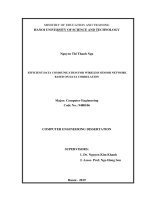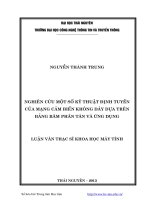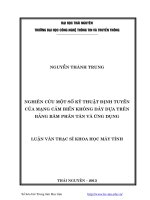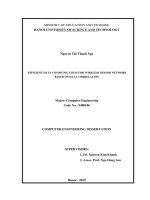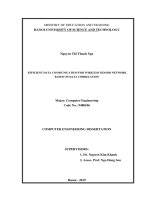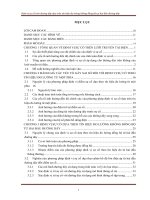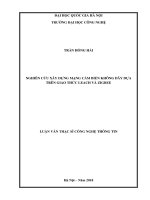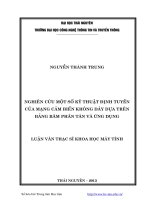Hiệu quả năng lượng cho các mạng cảm biến không dây dựa trên các ứng dụng internet
Bạn đang xem bản rút gọn của tài liệu. Xem và tải ngay bản đầy đủ của tài liệu tại đây (264.75 KB, 5 trang )
Journal ofScience & Technology 101 (2014) 145-149
Energy Efficiency for Wireless Sensor Networks Based
on Internet of Things
Thu Ngo Quynh', Chung Nguyen Due, Anh Nguyen Quynh
Hanoi University ofScience and Technology, No 1 Dai Co Viet Sir, Ha Noi, Viet Nam
Received: March 04, 2014: accepted' Aprd 22. 2014
Abstract
Recently, internet of Things (loT) enables the convergence of Wireless Sensor Networtand the connectivity of smart objects to the Internet by using RPL routing protocol for transmitting IPv6
over small sensor nodes of WSN One most important disadvantage of RPL is - many control messages of
RPL such as DIS, DIO and DAO can lead to the increase of energy consumption of sensors. That is why it
IS necessary to propose different solutions for energy savings in loT, In this paper, we propose three
energy efficient data processing schemes that are intergrated with RPL routing protocol and evaluate them
by using Contiki operation system. The simulation result shows that our schemes can help to save from 4
to 9% energy consumed.
Keywords, Energy Efficiency, Routing protocol, Internet of Things.
1. Introduction
Recently, Internet of Things (loT) becomes a
potential future scenario of the applicability and
impact of technology In human life. loT can extend
the concept of Internet fi-om a network of rather
homogeneous devices such as computers to network
of heterogeneous devices (home appliances,
consumer electronics or sensors nodes of Wireless
Sensor Networks). Since loT systems consist of
sensor nodes that have weak processing power, to
suit with new type of network, techniques used
Internet are required adjustment or even new
techniques, protocols or mechanisms are also
suggested.
For enabling the implementation of loT over
WSN or making IPv6 packets to be earned over
IEEE 802.4 feasible, IETF Working Group Routing
over Wireless Sensor Networks (WSN) investigated a
routing protocol named RPL [1] RPL was proposed
in RFC 6550 [2] because none of the existing known
protocols such as AODV, OLSR or OSPF could meet
the specification of Low power and Lossy Networks
(LLN), Networks running RPL are connected in such
a way that no cycles are present In order to have no
cycles, a Destination Oriented Directed Acyclic
Graph (DODAG), which is routed at a root, is built.
For establishing this DODAG, 4 types of control
messages are defined in RPL specification: DIO,
DAO, DIS and DAO-ACK
* Conespongdmg Author; Tel (+84)912.528.824
E-mail, ,edu vn
Expenmental measurements have shown that
data transmission in general costs expensive m terms
of energy con sumption while data processing
consumes significantly less energy [3], When
transmitting a single bit the energy cost is
approximately the same is thit needed for processing
a thousand operations in a t^pital sensor node [4]
This important feature influences the implementation
ot loT and the design ot RPL significantly because
RPL framework defines many control messages as
descnbed above (DIO, DAO, DIS,,,), Smce most of
nodes in a WSN are typically battery powered, it is
crucial to limit the amount of sent control messages
over the network That is why it is necessary to
propose different solutions for energy savmg of RPL
m loT One possibility is to adapt the sending rate of
DIO messages by extending the Trickle algorithm [5]
or using energy associated with battery index as
object fimcnon of RPL [6,7] Another possibility is to
implement data driven techniques that are designed
to reduce the amount of sampled data by keeping the
sensing accuracy within an acceptable level for the
appU cation.
In this paper, we utilize the data set of Intel
Berkeley research lab and present three methods
(intergrated with RPL) for reducing the amount of
this set. This reduced sampled data will be sent to the
root by using RPL routing protocol implemented in
Contiki operating system. The simulation results
show that our schemes can help to save from 4 to 9%
energy consumed for RPL
This paper is organized as follows. In Section
I, we present the background of data driven
Journal ofScience & Technology iwi {Miti) m-i^'i
techniques for energy efficiency in WSN, Section 3
describes the proposed data processing technologies
that are intergrated with RPL routing protocol.
Section 4 descnbes our simulation scenarios using
Contiki operating system and evaluate the
performance of these three methods. Section 5
concludes the paper and discuss our ongoing work.
2. Background
2.1 Energy conservation for WSN
In WSN, different data-driven techniques can
be used to improve the energy efficiency. In fact, data
.sensing impacts on sensor' energy consumption in
two ways:
• Unneeded samples. Normally, sampled data
have strong spatial and/or temporal
correlations [7]. That is why there is no need
to communicate the redundant data to the root,
• Power consumption of the sensing system.
Reducing communication is not enough when
the sensor Itself is power hungry.
In the first case, redundant samples result in
useless energy consumption, even if the cost of
sampling is negligible because they result in
unneeded communications. The second problem
arises whenever the consumption of the sensing
subsystem is not negligible Data driven techniques
presented in the following are designed to reduce the
amount of sampled data by keeping the sensing
accuracy within an acceptable level depending on the
requirement of applications
Data-driven techniques can be divided to: data
processing and energy efficient data acquisition
Specifically, data processing schemes address the
case of unneeded samples, while energy-efficient
data acquisition schemes often aimed at reducing the
energy consummed by the sensing subsystem.
However, some of them can reduce the energy spent
for communication as well.
In this paper, it is important to discuss here
one more classification level related to dataprocessing algonthms. All these approaches aim at
reducing the amount of data to be delivered to the
root. However the design principles of these
approaches are rather different.
In-network
processing performs data aggregation at intermediate
sensors between the sources and the root. By doing
this, the amount of data is reduced while traversing
the network towards the root. The most appropnate
in-network processing technique depends on the
specific application and must be tailored to it. In [8]
an up-to-date survey about in-network processing
approaches is presented. Data compression can be
applied to reduce the amount of data sent by sources.
This scheme includes encodmg information at
sensors which generate data, and decoding it at the
root There are different methods for compressing
data [9-14], As compression techniques are general
(i.e, not necessanly related to WSNs), we will omit a
detailed discussion of them to focus on other
approaches specifically tailored to WSNs. Data
prediction consists of building an abstraction of a
sensed phenomenon, i,e, a model descnbing the
evolution of data. The model can predict the values
sensed by sensors, and resides both at the sensors and
at the root. On the other side, explicit communication
between sensor nodes and the sink is needed when
the model is not accurate enough, i.e. the actual
sample has to be retrieved and/or the model has to be
updated. On the whole, data prediction reduces the
number of data sent by sensor nodes and the energy
spent for communication as well. Data reduction are
schemes that reduce the amount of data sent by
source by removing unneeded samples.
In this paper, we are concentrated on
developing data processing schemes intergrated with
RPL routmg protocol for the data set of Intel
Berkeley Research, This reduced sampled data will
be sent to the root using RPL routing protocol
implemented in Contiki operating system. In the next
section, the characteristics of this data set are
examined.
2.2 Data set of Intel Berkeley lab
The data set used in this paper is collected from Intel
Berkeley Research lab It consists of temperture,
humidity and light intensity that are sampled each 31
seconds. Some samples of these memcs are presented
in the above table. From this table, we realize that
temperature and humidity vary slowly while light
intensity stays unchanged during a long period. From
this point of view, we propose three data processing
schemes: data reduction using difference, linear data
prediction and entropy-based data reduction. These
three methods are presented in the following section.
Table 1. Variation of three metrics
Tetnperatiire
Humidity
Light
Intensity
19.9884
37.0933
45.08
19.3024
37.0933
45 08
19.1652
38.4629
45.08
19.1456
38.8039
45.08
Journal ofScience & Technology 101 (2014) 145-149
3. Data driven techniques
3.1 Linear data prediction
The most important characteristic of this data
set is that all three metncs varies slowly according
the time. That is why it is possible to implement a
data linear predicted function that can predict Ihe
value of a sample (temperature, humidity or light
intensity) based on n data samples collected
previously Affer that RPL transmits only the
difference between real data value and its predicted
value. By implementing an appropriate linear data
predicted fimction, this difference is smaller than the
original sample and transmitting only this difference
can reduce energy consumption significantly. Details
of this scheme are described as follows:
Step 1. Sensors collect values of n samples 5 s ( 0
with i=l..n, save these values and transmit towards
root. Root receives this data and saves for later
process.
Step 2. The next data value at (n+1)"' sample is
collected by sensors. At this time, sensors predict also
the value of this data sample by using following
linear prediction function:
gin + 1) = CnflOO + c„_i5Gi - l ) -I- - + Cjg 4(2)
where flsCO is data value at i"' sample with i=l .n,
g,Oi-l- l ) f t ( « -I- l)is predicted value, q with i=l n
is predicted coefficient that satisies following
condition:
c„ > £-„_! > ••• > c^ > 0
and
I?=lCi = 1.
Step 3. Sensors evaluate difference between original
and predicted value according to the following
equation:
^9s = SsCn + l ) - a t ( n - l - l )
This difference is transmitted to the root using
RPL routing protocol of loT
memory for saving n samples and the calculation of
linear predicted function consumes also much energy.
That is why we present in the next section another
data reduction algorithm usmg difference between
two consecutive data samples.
3.2 Data reduction
consecutive samples:
using difference
between
As described in previous sections, three
metncs of this data set (temperture, humidity and
light intensity) vary slowly according the time. That
IS why the difference between two consecutive
samples stays small compared to original samples. By
transmitting only this difference, we can achieve
energy efficiency for RPL routing protocol The
detail of this data reduction method is described as
follows:
Step 1. Sensors collect the data value of /"' sample
§5 (l), save this value and transmit to the root At the
root, this value g^ (l) is received
Step 2. Sensors collect next data sample and evaluate
the difference between the P' and 2'"' values:
i&=S.<2)-S.(l)
Step 3. Sensors transmit this difference towards root
Step 4. Root receives this difference and evaluate the
value of 2"^ sample by implementing this equation
5fl(23=5fl(l)+Afl„
Step 5. Root and sensor clear the value of / " sample
while keeping 2"'' sample.
Obviously, the difference-based algorithm is
more simple than linear predicted scheme because it
does not require to save n samples and the calculation
of only the difference between two consecutive
samples consumes less energy than the calculation of
linear predicted function. In the following figure, we
present the data collected at sensors when
implementing these two strategies applying to 5
samples and the original data-
From this figure, we find that the difference
between original data and data after precessing of the
first strategy (linear prediction) is higher than the
second strategy That is why the second method can
SB (« + ! ) = c^Bs W + %-iSfi in-i}
+ - + c^g^ (1) achieve better energy efficiency. This comment will
be reexamined in different simulation scenarios
It reevaluates the value of data at (n+1)'''
described in section 4.
sample as followsStep 4, Root receives this difference and recalculates
the linear predicted fiinction:
5HCn-|-l)=fl.Cn-|-l)-|-Afl«
Step 5. Sensors and root clear data at die / " sample
and save data value of f>i-i-7/* sample for later use
This strategy can reduce the amount of sampled data
and it is more energy efficient when transmitting only
this difference. However, this method requires more
Fig. 1. Data collected at sensors
Journal ofScience & Technology 101 (2014) 145-149
3.3 Entropy-based Data Reduction
In the following figure, we present the value
of temperature collected at sensors when applying
entropy-based threshold of 0.02 and 0.01. We realize
that this difference is negligible compared to the
origmal data value. For humidity, the characteristic of
data is similar to temperature and we can also apply
an entropy-based threshold. Unlike temperature and
humidity, light intensity stay unchanged during a
Pin-^2-Vn)l0S2pin'-^2--^) long period.
In this section, we present a data reduction
algorithm that utilizes an entropy-based threshold in
order to decide when sensors need to transmit data
towards root. In order to receive this threshold, it is
necessary to calculate the entropy value of data
according to the following function:
HiV^.V, ...Vi) = - 2 ]
where V^ with i=l..n is sensor node, v^ is data
collected at this node (, pCi'i-i'i-.t^} is the joint
probability distnbution fimction ofVi_,i?2•••!'„, After
calculating this entropy value, we select an entropythreshold based that examines the increment of the
increased amount entropy AHii). The value of dW(i)
can be calculated as follows:
d//CO .
rHCFi...^) -WC^i ...V^_t)withi>
^
1 with i = 1
1
4. Performance evaluation
In this section, we implement three above
techniques intergrated with RPL routing protocol by
using Contiki operating system. The simulated
topology consists of 15 nodes. Nodes that have rank I
are (2,3,6-8,12)andnodes that have rank 2 are (1,5,7,
9-11,13-16), Input data is the data set received at
Intel Berkeley research once each 31s. Root is
situated in the middle of the topology.
Please refer to [15] for more information
relating the calculation of entropy-based threshold.
In this topology, we evaluate the performance
of 4 following scenarios:
Step 1. Sensors collect the value of / " data sample
fljCl), save it and transmit to root by using RPL
routing protocol. Root receives the value gg (l).
- In the 1" scenario, all three meh-ics
temperature, humidity and light intensity are
transmitted in a RPL IPv6 packet without data
driven techniques.
- In the 2"'' scenario, we apply the linear
predicted data reduction algonthm for M=5
samples (in case of temperature and hunidity
only).
- In the J"^ scenario, data reduction algorithm
using difference between consecutive samples
are implemented.
- In the 4'* scenario, we implement entropybased data reduction algorithm with the
entropy threshold 0.0196 for temperature, 0.05
for humidity and 0 for light intensity.
In the following figure, energy consumed of
2"'' scenario is compared to the P' one.
Step 2. Nodes collect 2"'' data value and evaluate the
difference: Aflj = g, il) — fljCl).
Step 3. If this difference is higher than the enfropybased threshold Ags > Hyjj.gai,oi(j, nodes will transmit
this value to the root. If not, nodes do not transmit
data.
Step 4. Root receives this difference Ag^ and
evaluate the value of 2"'' sample by applying the
equation 5^ (2) =g (l) + Ag^ ,giiC2) = g t l } -I- AgR
Step 5. Nodes and root clear the value of 1" sample
and while keeping the value of 2'"' sample.
ig. 2. Data collected at sensors of 3"* scheme
From this figure, we realize that linear
predicted data redimction algorithm achieves better
energy efficiency compared to the scenario without
data driven techniques (4.07%). However, the
difference of energy consumption between two
methods is not much because of the complexity of
this data reduction (large memory for saving n
samples and complex calculations for linear predicted
function). For 3"^ scenario, energy consumed is
presented in the following figure:
Fig. 3, Simulated Topology
Fig. 4. Energy of 2"'' and V scenarios
Journal ofScience & Technology 101 (2014) 145-149
Fig. 5. Energy of 3'*' and 1 ^' scenarios
V]
Fig. 7. Energy of all 4 scenarios
We realize that the data reduction method
based on difference between two consecutive samples
achieves also better energy efficiency than the P'
scenario (5%). It can be explained simply because all
three metrics change slowly and the energy
consumed for transmitting difference between
consecutive samples stays small.
[8]
Next, we examine energy efficiency of 4"'
scenario Obviously, in the entropy-based method
energy consumed is small compared to the 1"
scenario.
[10]
More concretelly, the energy efficiency of all
4 scenarios is presented together in the following.
The last scenario with entropy-based data reduction
method achieves the best energy efficiency — 9%.
[9]
[II]
[12]
5. Conclusion
In this paper, we present three data processing
methods, linear prediction, data reduction based on
difference and data reduction based on entropythreshold. These three methods are also intergrated
with RPL routing protocol for transmitting data to the
root by using IPv6 protocol. Simulation results by
Contiki show that entropy-based data reduction
method can save to 9% energy consummed, while
method using difference between consecutive
samples and linear predicted function achieve only
5% and 4%.
[13]
[14]
[15]
G. Montenegro, N. Kushalnagar, J Hui, and D.
Culler, "Transmission of IPv6 packets over IEEE
802.15 4 networks," IETF, RFC 4944, 2007,
A- Brandt, J. Hui, R. Kelsey, P Levis, K Pister, R
Slmik, JP. Vasseur, R.Alexander, RPL, IPv6 Routing
Protocol for Low-Power and Lossy Networks. IETF
RFC 6550, May 2012.
V Raghunathan, C. Schurghers, S Park, M.
Snvastava, Energy-aware
wireless microsensor
networks, IEEE Signal Processing Magazine (2002)
40-50
G. Pottie, W Kaiser, Wireless integrated network
seusors, Communication of ACM 43 (2000) 51-58
P, Levis, N Patel. D, Culler, and S Shenker, Trickle:
A self-regulatmg algorithm for code maintenance and
propagation m wireless sensor networks In
Proceedmgs of the USENIX NSDI Conference, San
Francisco, CA, USA (2004) 15-28,
A, Barbato, A Capone, M. Barrano, N Figiani.
Resource Onented and Energy Efficienl Routing
Protocol for IPv6 Wireless Sensor Networks, IEEE
Online Conference on Green Communications (2013)
163-168
Cheng-Yen Liao, Lin-Huang Chang, Tsung-Han Lee,
Shu-Jan Chen, An Energy-Efficiency-Oriented
Routing Algorithm over RPL. AIT Conference 2013,
M,C Vuran, OB, Akan, l.F, Akyildiz, Spatiotemporal correlation- theory and applications for
wireless sensor networks, Computer Networks
Joumal 45 (3) (2004) 245-261.
E. Fasolo, M. Rossi, J. Widmer, M Zorzi, hi-network
aggregation techniques for wireless sensor networks:
a survey, IEEE Wireless Communications 14 (2007)
70-87S.S. Pradhan, K. Ramchandran, DisQributed source
coding using syndromes (DISCUS) design and
constraction, IEEE Transactions on Information
Theory 49 (2003) 626-643
C Tang, C S Raghavendra, Compression Techniques
for Wireless Sensor Networks, Book Wireless Sensor
Networks, Kluwer Academic Pubhshers , (2004) 207231 (Chapter 10).
M. Wu, CW. Chen, Multiple Bh Stream Image
Transmission over Wireless Sensor Networks, Book
Sensor Network Operations, IEEE & Wiley
Interscience (20O6) 677-687 (Chapter 13)
Z. Xiong; A.D. Livens, S. Cheng, Distributed source
codmg for sensor networks, IEEE Signal Processing
Magazine 21 (2004)80-94,
Pietro Gomzzi, Gianluigi Fenari, Paolo Medagliani,
Jeremie Leguay. Data Storage and Retrieval with RPL
routing 9* Wireless Communications and Mobile
Computing Conference IWCMC (2013) 1400-1404.
Hiroaki Taka, Hideyuki Uehara, Takashi Ohira,
Intermittent Transmission Method based on
Aggregation Model for Cluslenng Scheme, IEEE
ICUFN (2011) 107-111,
